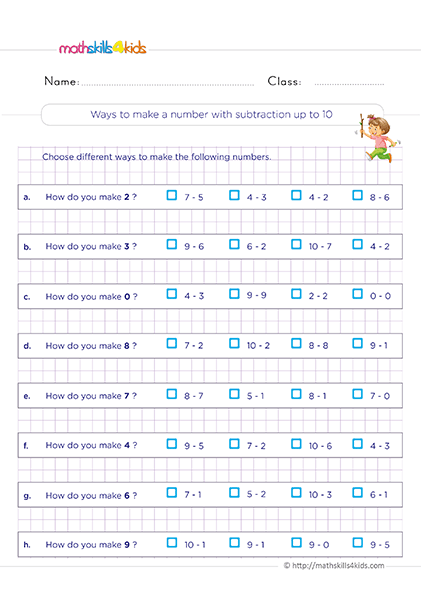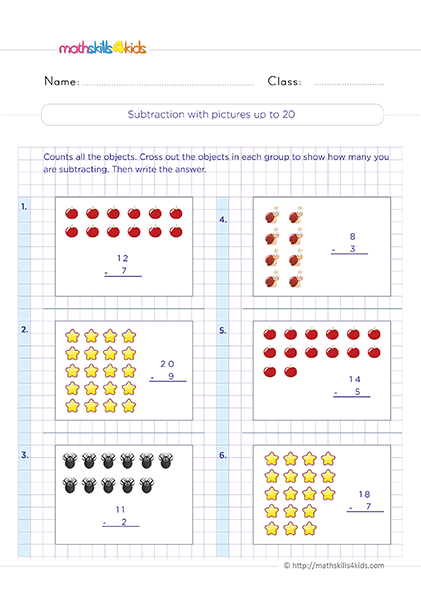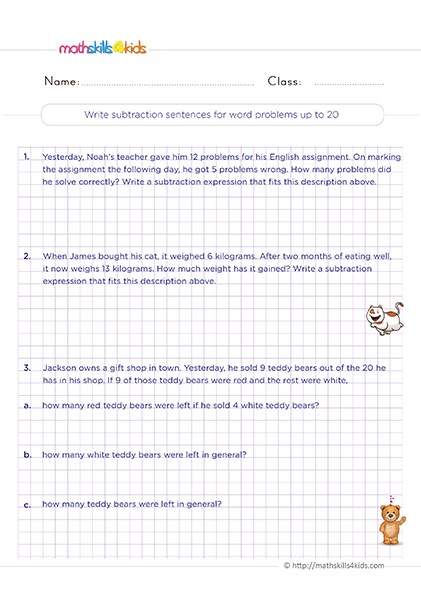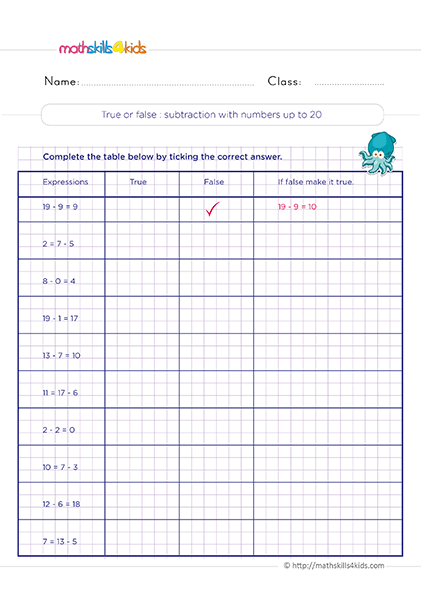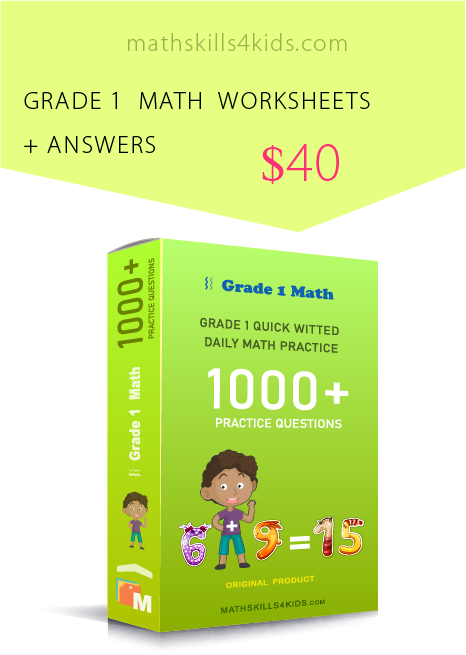Mastering subtracting 1-digit strategies: 2nd Grade worksheets and activities
Are you ready to help your 2nd graders master the strategies for subtracting 1-digit numbers? Do you want them to learn easy and fun ways to improve their math skills? If you answered yes, then this is the perfect article for you! Here, you will find excellent 2nd Grade worksheets and activities with everything you need to help your child to become a subtraction superstar in 2nd Grade. You will discover:
-
- How to subtract 1-digit numbers with ease: tips and tricks for 2nd graders
- Fun and engaging activities to practice subtracting 1-digit numbers
- Worksheets to reinforce subtracting 1-digit numbers skills
- Common mistakes and how to avoid them when subtracting 1-digit numbers
- Challenge yourself: subtracting 1-digit numbers with regrouping
Let's get started!
How to subtract 1-Digit numbers with ease: Tips and tricks for 2nd Graders
Subtracting 1-digit numbers may seem simple, but it can be tricky sometimes. That's why it's important to teach some strategies to help 2nd graders practice subtracting 1-digit numbers with ease, faster, and more accurately. Here are some subtraction tips and tricks for 2nd graders:
- Use a number line. A number line is a great tool to visualize subtraction. Kids can use it to count backward from larger to smaller numbers. For example;
To subtract 7 - 4, start at 7 on the number line and move 4 units to the left. The number you land on is the answer: 3.
- Use your fingers. Another way to count backward is to use your fingers. You can hold up the larger number of fingers and then fold down the smaller number of fingers.
The number of fingers that are still up is the answer. For example, to subtract 6 - 2, hold up 6 fingers and then fold down 2 fingers. The number of fingers that are still up is 4.
- Use fact families. Fact families are groups of related addition and subtraction facts that use the same three numbers. For example, the fact family for 3, 4, and 7 is:
3 + 4 = 7 ; 4 + 3 = 7 ; 7 - 3 = 4 ; 7 - 4 = 3
Mastering fact families helps kids to remember subtraction facts. For example, if you know that 3 + 4 = 7, then you also know that 7 - 4 = 3.
-
BROWSE THE WEBSITE
-
DOWNLOAD FREE WORKSHEETS
-
-
2nd GRADE MATH TOPICS
- Counting and numbers
- Comparing and ordering
- Reading and writing numbers
- Shape patterns
- Adding of 1-digit numbers
- Subtracting of 1-digit numbers
- Additing 2-digit numbers
- Subtracting within 2-digits
- Up to 3-digit addition
- Subtracting within 3-digit
- Properties of addition & subtaction
- Mixed operations
- Place-value
- Estimating and rounding
- Logical reasoning
- Money Math
- Telling Time
- Data and graphing
- Units of measurement
- 2D shapes
- 3D shapes
- Geometric measurement
- Fractions
- Probability
- Multiplication
- Division
-
-
-
Fun and engaging activities to practice subtracting 1-digit numbers
Now that your 2nd graders already know some strategies to subtract 1-digit numbers, it's time for them to practice these subtracting 1-digit numbers with fun and engaging activities.
Here are some ideas that you can try:
- Play a card game. Kids can use a deck of cards to play a subtraction game with friends or family members.
Remove the face cards (J, Q, K) and the ace (A) from the deck. Shuffle the cards and deal them evenly between the two players.
Each player turns over two cards and subtracts the smaller number from the larger number. The player with the higher answer keeps all four cards.
If both players have the same answer, they have a war: they each turn over two more cards and subtract them. The player with the higher answer keeps all eight cards.
The game ends when one player has no more cards or whth players run out of cards. The player with more cards at the end wins.
- Make a subtraction bingo. Your kids can make their own subtraction bingo cards by writing different subtraction problems on a grid of squares. For example, they can write:
|7 - 5|9 - 3|6 - 2|
|8 - 4|5 - 1|10 - 6|
|9 - 6|7 - 2|8 - 5|
They can also use online tools to generate random subtraction bingo cards. Then, use another grid of squares to write the answers to the subtraction problems. For example, write:
|2|6|4|
|5|3|9|
|8|1|7|
Now, cut out the squares with the answers and put them in a bowl or a hat. Then, play bingo with a friend or a family member.
Each player gets a bingo card with subtraction problems. One player draws an answer from the bowl or hat and calls it out loud.
The other player looks for a subtraction problem on their bingo card that matches the answer and covers it with a marker (such as a coin or a button).
The first player to cover five squares in a row, column, or diagonal wins.
- Play a card game. Kids can use a deck of cards to play a subtraction game with friends or family members.
-
Worksheets to reinforce subtracting 1-digit numbers skills
Another way to reinforce subtracting 1-digit numbers to your 2nd graders is by using our subtracting 1-digit worksheets. These worksheets can help you review what you have taught your kids and check their understanding.
You can find many subtraction worksheets online or encourage your kids to make their own. Here are some examples of subtraction worksheets that you can use:
- Horizontal subtraction. In this worksheet, kids must subtract two 1-digit numbers written horizontally. For example:
7 - 4 = __
6 - 2 = __
9 - 3 = __
- Vertical subtraction. In this worksheet, kids must subtract two 1-digit numbers written vertically. Align the digits so they can write the answer below the line.
For example:
8––
– 5––
- Missing number subtraction. Kids must find the missing number in a subtraction equation in this worksheet. The missing number can be the minuend (the larger number), the subtrahend (the smaller number), or the difference (the answer). For example:
__ - 4 = 3
6 - __ = 2
9 - 6 = __
-
Common mistakes and how to help kids avoid them when subtracting 1-digit numbers
Subtracting 1-digit numbers may seem easy, but sometimes you must correct things. Here are some common mistakes and how to help kids avoid and fix them when subtracting 1-digit numbers:
- Subtracting the larger number from the smaller number. Sometimes, your second grader may need to remember which number is larger or smaller when subtracting.
This can lead to negative answers, which are not correct for 2nd-grade math.
Hence to help them avoid this mistake, remind them always to check which number is larger and which number is smaller before subtracting.
You can advise them to use a number line or your fingers to compare the numbers. For example, if you want to subtract 5 - 7, you should notice that 7 is larger than 5, so you cannot subtract it from 5. You should switch the order of the numbers and subtract 7 - 5 or use regrouping (see below) to subtract 5 - 7.
- Forgetting to borrow or regroup when subtracting with regrouping. Sometimes, kids may encounter exercises requiring subtracting two numbers that require regrouping.
Regrouping means you have to borrow a ten from the next-place value and add it to the ones-place value. For example;
If you want to subtract 12 - 8, you cannot subtract 8 from 2 in the ones place because 8 is larger than 2. You have to borrow a ten from the tens place and add it to the ones place, making it 12 - (10 + 2). Then, you can subtract as usual: (10 + 2) - 8 = (10 - 8) + (2 - 0) = 2 + 2 = 4.
To help kids remember to borrow or regroup, encourage them to alwayalways to checksubtrahend is larger than the minuend in the onesce.
If it is, then borrow or regroup before subtracting.
- Subtracting the larger number from the smaller number. Sometimes, your second grader may need to remember which number is larger or smaller when subtracting.
-
Challenge Your 2nd graders: Subtracting 1-Digit numbers with regrouping
Are you ready to take your kid's subtracting skills to the next level? If they have mastered subtracting 1-digit numbers without regrouping, you can help them try subtracting 1-digit numbers with regrouping.
Regrouping means borrowing a ten from the next place value when the ones digit in the minuend is smaller than the ones digit in the subtrahend.
For example, in 15 - 7, you need to regroup because 5 is smaller than 7. You can borrow a ten from the tens place and add it to the ones place, making it 15 - 7 = (10 + 5) - 7 = (10 + (5 + 10)) - 7 = (10 + 15) - 7 = 25 - 7 = 18.
Regrouping can be tricky at first, but with some practice, your Grade 2 kids can master it. Here are some tips to help you:
- Always start from the rightmost place value and move to the left.
- If the ones digit in the minuend is smaller than the ones digit in the subtrahend, regroup by borrowing a ten from the next place value.
- If the tens digit in the minuend is smaller than the tens digit in the subtrahend after regrouping, regroup again by borrowing a hundred from the next place value.
- Write down each step of your calculation and check your work carefully.
We have prepared some fun and engaging activities to help kids practice subtracting 1-digit numbers with regrouping. You can find them in the link below. You can also download some worksheets to reinforce your teaching skills and check your kid’s answers with the answer key.
Bonus: Find more resources to reinforce strategies for subtracting 1-digit numbers skills in second Grade here!
Here are some excellent resources that you can use to reinforce strategies for subtracting 1-digit numbers in a fun and engaging way!
- Watch this video from Khan Academy that explains how to subtract 1s, 10s, and 100s using place value blocks and number lines. You can also practice with interactive exercises and get instant feedback. Visit https://www.khanacademy.org/math/cc-2nd-grade-math/cc-2nd-add-subtract-1000/cc-2nd-sub-ones-tens-hundreds/v/subtracting-3-digits to learn more.
- Check out this blog post from Teach Starter that offers six subtraction strategies to help students with mental math. You'll find helpful tips, examples, and printable resources to support your teaching. Whether you want to use the make ten, adding up doubles facts, or split strategy, you'll find something useful here. Go to https://www.teachstarter.com/au/blog/subtraction-strategies-help-students-mental-maths/ to read more.
- Explore this website from Teach Starter that provides a guide for teaching subtraction in the early years. You'll discover how to use concrete materials, visual models, and games to help students understand subtraction concepts and develop fluency. You'll also find a variety of subtraction worksheets, posters, and activities that you can download and print for your classroom. Visit https://www.teachstarter.com/us/blog/subtraction-strategies-a-guide-for-teaching-subtraction-early-years-2/ to get started.
Thank you for sharing the links of MathSkills4Kids.com with your loved ones. Your choice is greatly appreciated.
We hope you and your child enjoy our shape pattern worksheets and activities. Remember to praise your child for their efforts and achievements.
Have fun mastering shape patterns together!
We hope your 2nd graders enjoyed this article and learned much about subtracting 1-digit numbers. Subtracting is an essential skill that yearly math learners will use in many situations in life.
By helping your Grade 2 kids in mastering subtracting 1-digit numbers, they build a strong foundation for more advanced math topics.
Keep practicing with your kids, and have fun!
-
